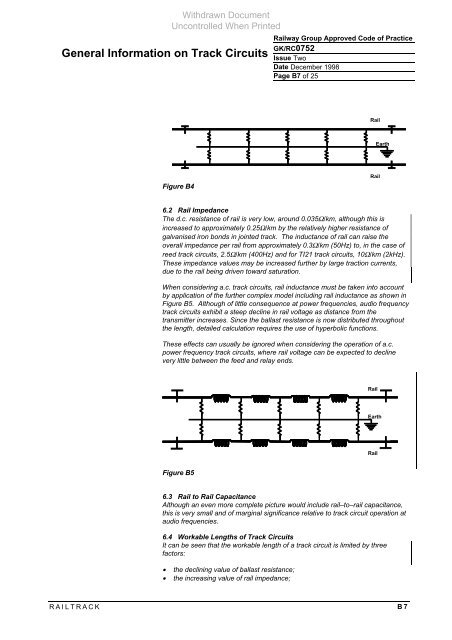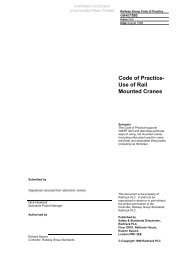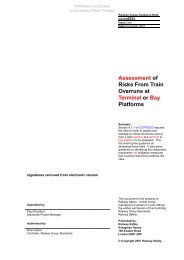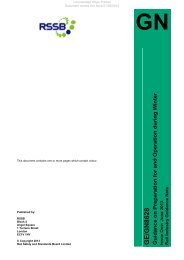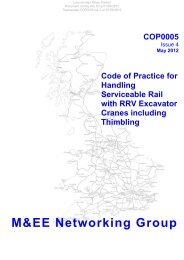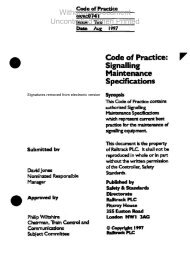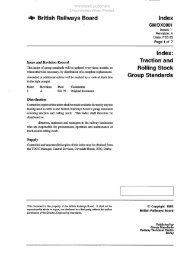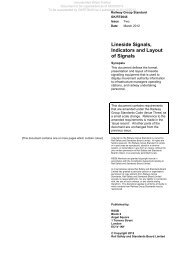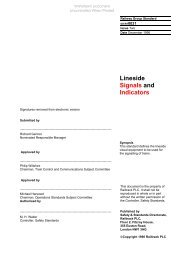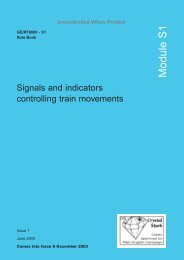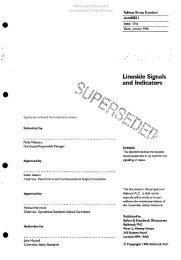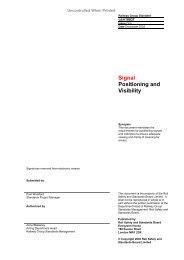General Information on Track Circuits - RGS Online
General Information on Track Circuits - RGS Online
General Information on Track Circuits - RGS Online
You also want an ePaper? Increase the reach of your titles
YUMPU automatically turns print PDFs into web optimized ePapers that Google loves.
Withdrawn Document<br />
Unc<strong>on</strong>trolled When Printed<br />
<str<strong>on</strong>g>General</str<strong>on</strong>g> <str<strong>on</strong>g>Informati<strong>on</strong></str<strong>on</strong>g> <strong>on</strong> <strong>Track</strong> <strong>Circuits</strong><br />
Figure B4<br />
Railway Group Approved Code of Practice<br />
GK/RC0752<br />
Issue Two<br />
Date December 1998<br />
Page B7 of 25<br />
RAILTRACK B7<br />
Rail<br />
Rail<br />
Earth<br />
6.2 Rail Impedance<br />
The d.c. resistance of rail is very low, around 0.035Ω/km, although this is<br />
increased to approximately 0.25Ω/km by the relatively higher resistance of<br />
galvanised ir<strong>on</strong> b<strong>on</strong>ds in jointed track. The inductance of rail can raise the<br />
overall impedance per rail from approximately 0.3Ω/km (50Hz) to, in the case of<br />
reed track circuits, 2.5Ω/km (400Hz) and for TI21 track circuits, 10Ω/km (2kHz).<br />
These impedance values may be increased further by large tracti<strong>on</strong> currents,<br />
due to the rail being driven toward saturati<strong>on</strong>.<br />
When c<strong>on</strong>sidering a.c. track circuits, rail inductance must be taken into account<br />
by applicati<strong>on</strong> of the further complex model including rail inductance as shown in<br />
Figure B5. Although of little c<strong>on</strong>sequence at power frequencies, audio frequency<br />
track circuits exhibit a steep decline in rail voltage as distance from the<br />
transmitter increases. Since the ballast resistance is now distributed throughout<br />
the length, detailed calculati<strong>on</strong> requires the use of hyperbolic functi<strong>on</strong>s.<br />
These effects can usually be ignored when c<strong>on</strong>sidering the operati<strong>on</strong> of a.c.<br />
power frequency track circuits, where rail voltage can be expected to decline<br />
very little between the feed and relay ends.<br />
Figure B5<br />
Rail<br />
Earth<br />
6.3 Rail to Rail Capacitance<br />
Although an even more complete picture would include rail–to–rail capacitance,<br />
this is very small and of marginal significance relative to track circuit operati<strong>on</strong> at<br />
audio frequencies.<br />
6.4 Workable Lengths of <strong>Track</strong> <strong>Circuits</strong><br />
It can be seen that the workable length of a track circuit is limited by three<br />
factors:<br />
• the declining value of ballast resistance;<br />
• the increasing value of rail impedance;<br />
Rail


